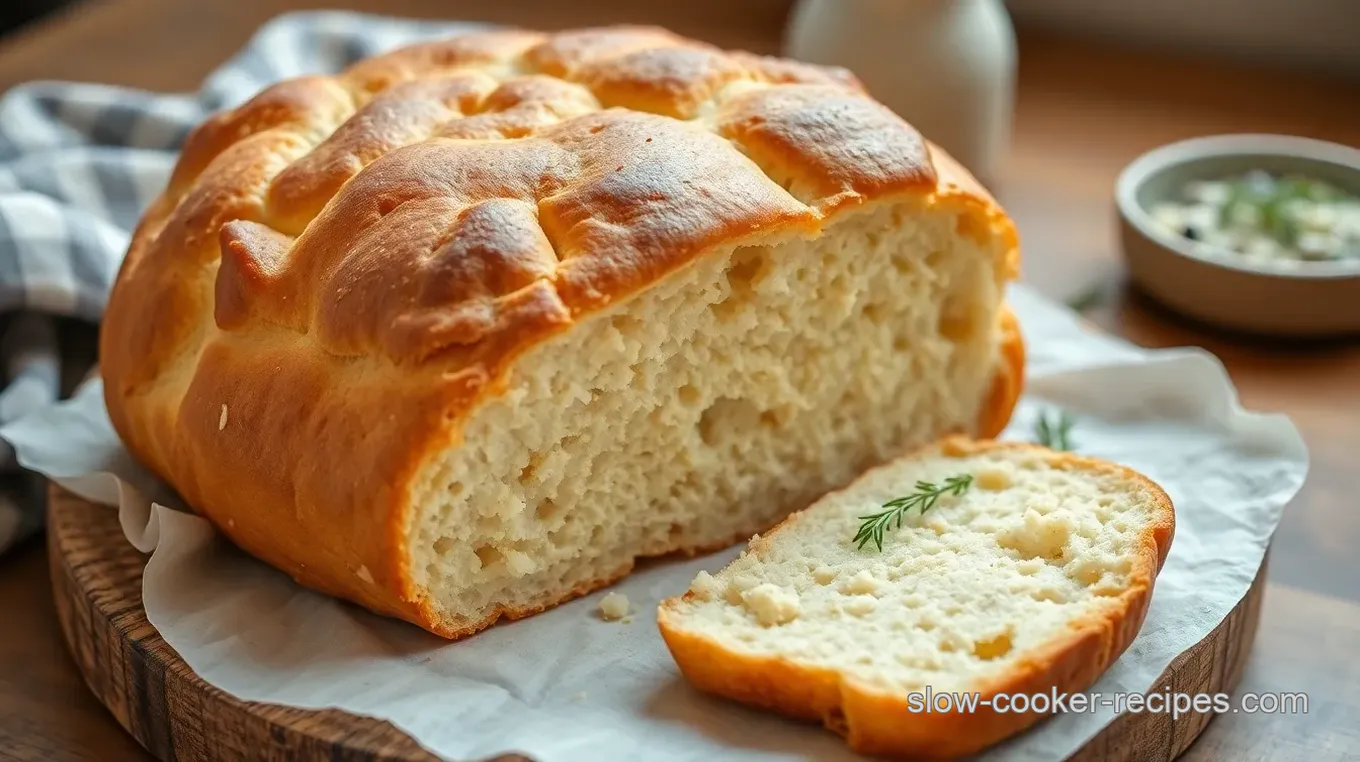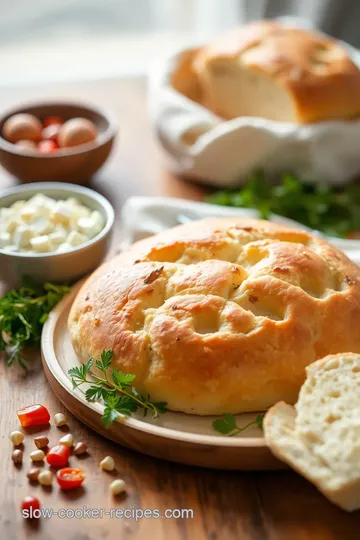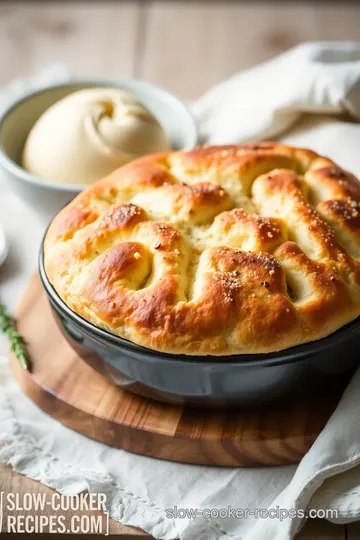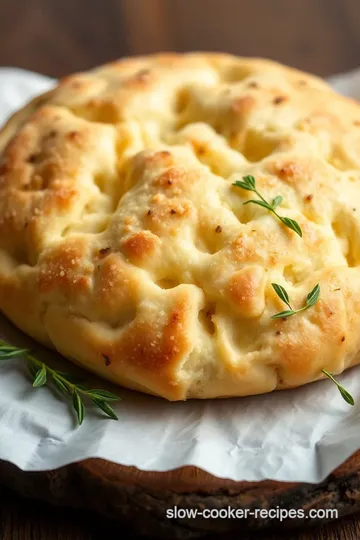No Knead Focaccia Bread - Soft & Flavorful
Have you ever tried making No Knead Focaccia Bread - Soft & Flavorful? It's a game-changer! This airy Italian flatbread is perfect for dipping and morning meals. Let's bake!

- A Bread Lover’s Dream: No Knead Focaccia Bread - Soft & Flavorful
- Essential Ingredients Guide for No Knead Focaccia Bread - Soft & Flavorful
- Mastering the Art of No Knead Focaccia Bread - Soft & Flavorful
- Pro Tips & Secrets for Amazing Focaccia
- Perfect Presentation: Taking It Up a Notch
- Storage & Make-Ahead: Embrace the Convenience
- Creative Variations: Get Wild with Flavors
- A Warm Encouragement to Get Baking
- Frequently Asked Questions
- Recipe Card
A Bread Lover’s Dream: No Knead Focaccia Bread - Soft & Flavorful
Oh my gosh, let me tell you about the first time i attempted to make bread. picture this: me, standing in my tiny kitchen, flour everywhere, trying to knead dough like i was a certified baker.
Spoiler alert: it was a disaster. fast forward to today, and i’ve found my holy grail— no knead focaccia bread - soft & flavorful .
Seriously, it’s like a hug in bread form. if you’ve ever wondered how to whip up a stunning loaf without the fuss, you’re in for a treat!
You know, focaccia has roots that go way back to ancient roman times, even before i could wiggle my toes! it started as a humble italian flatbread, often topped with whatever fresh herbs were on hand.
Nowadays, it’s a rock star in the bread world—and for good reason. in a world filled with gluten-free and low-carb diets, a fresh stack of this rustic italian bread, drizzled with olive oil and sea salt, stands its ground.
Best of all, anyone can make it! this easy focaccia bread really hits the sweet spot in skill level; if you can mix some ingredients and let them chill out for a while, you're golden.
The beauty of this recipe? you don’t have to babysit it. it requires just about 15 minutes of active prep and a good overnight rest.
You’ll need about 12 to 16 hours of waiting for it to puff up, but hey, you’ve got that netflix show queued up, right? once it’s all set, the baking time is only 25 to 30 minutes .
Talk about an easy baking win!
And the best part? you can make 8 servings out of this deliciousness! so, you can share (or not—no judgment here!).
If you’re thinking of costs, it’s very budget-friendly, requiring just flour, water, salt, yeast, and some olive oil. you can’t really beat that when you’re aiming for a tasty, homemade delight.
Why You’ll Love This Focaccia Recipe
Let’s take a quick detour to talk benefits. first up, health perks ! this focaccia’s nutrition info is pretty chill—no weird additives, just wholesome ingredients.
Plus, with that olive oil magic, you’ve got healthy fats working for you. you can throw in some herbs like rosemary or thyme for an extra flavor punch, turning this into a herb-infused masterpiece .
Not to mention, this homemade bread without kneading seriously shines for special occasions. you can whip it up for family dinners, serve it at parties, or even enjoy it as a snack while bingeing on your favorite series.
It’s like the mediterranean flatbread treat you didn’t know you were missing.
And if you’re a fan of experimenting in the kitchen, the focaccia bread variations are endless! feeling indulgent? load it up with roasted garlic and cheese or top it with colorful cherry tomatoes.
The possibilities are as vast as your imagination!
Plus, let’s talk about dipping oil for bread . you can pair your warm focaccia with olive oil mixed with balsamic vinegar, or even some homemade herbed butter.
Trust me, your taste buds will thank you.
Making It Yours
Now, i know you’re itching to dive into those ingredients. just think: warm dough, drool-worthy toppings, and that incredible aroma wafting through your kitchen.
So let’s gather what you need to make this the star of your next meal. just remember, don’t rush it .
The no-knead method deserves some love and patience, and the results are totally worth it!
Once you have everything ready, we’ll dive into the magic of creating your soft and fluffy focaccia . Get ready for your kitchen to smell like a dream and for your loved ones to rave about your bread-making skills!
So, let's gather those ingredients and make some mouthwatering focaccia bread with herbs! What are you waiting for? It’s time to bake!

Essential Ingredients Guide for No Knead Focaccia Bread - Soft & Flavorful
Oh my gosh, let’s dive deep into the essential ingredients that make up your dream no knead focaccia bread - soft & flavorful ! this guide isn’t just about what to toss into the bowl.
It covers how to pick the best ingredients and what tools you’ll need to whip up a piece of heaven.
Premium Core Components
First off, let’s talk measurements . In this no-knead bread recipe, you’ll need:
- 4 cups (480g) of all-purpose flour
- 2 teaspoons (9g) of salt
- 1 teaspoon (4g) of instant yeast
- 1¾ cups (420ml) of warm water (aim for 110° F or 43° C )
- Plus, ¼ cup (60ml) of extra virgin olive oil for that richness.
For the best results, aim for high-quality flour and olive oil. Good ingredients make a serious difference!
When it comes to storage , keep those dry ingredients in a cool, dry place. your flour will last about 6-8 months in the pantry, while olive oil needs to be consumed within 3-6 months after opening.
And remember, if your olive oil smells rancid, toss it. freshness is key to a flavorful focaccia !
Signature Seasoning Blend
Now, let’s sprinkle on some flavor! Keep it simple yet impactful.
- Essential Spice Combos : Think salt and herbs! The classic sea salt and rosemary do the trick here.
- Herb Selections : Fresh rosemary or thyme is the go-to, but hey, if you’ve got fresh basil or parsley lying around, toss those in too!
- Flavor Enhancers : For a twist, drizzle your focaccia with infused olive oil—like garlic or chili oil. Yum!
Variations? heck yes! you can totally experiment with toppings. toss on some cherry tomatoes, olives, or even caramelized onions for a delightful kick.
The rustic italian bread game is all about personal flair!
Smart Substitutions
So maybe you’re missing a few things? Don’t sweat it; I've got your back.
- Common Alternatives : If you’re low on all-purpose flour, bread flour works too. It might slightly change the texture, but still delish!
- Dietary Modifications : Got a gluten sensitivity? A gluten-free blend will still yield a beautiful loaf if you follow the proportions closely.
- Emergency Replacements : No olive oil? Use melted butter! It may alter the flavor a smidge, but it’ll still be killer.
Oh, and don’t forget about seasonal options. fresh herbs are often cheaper in summer when they’re abundant. you could also grow your own if you’re feeling adventurous.
Trust me, nothing beats home-cooked meals with home-grown herbs!
Kitchen Equipment Essentials
Now onto the tools! You don’t need fancy equipment, but there are a few must-haves:
- A large mixing bowl for your dough.
- A wooden spoon works wonders for mixing and no fancy gadgets needed!
- Don’t forget a baking sheet or a cast iron skillet to bake your focaccia in. Each option will give you a different texture, but both rock!
Pro tip: Using a cast iron skillet can take your Easy Focaccia Bread to the next level! It heats evenly and gives that gorgeous crust.
A Wrap Up Before We Bake!
Alright, so now that you’re armed with all this knowledge, you're ready to tackle the no knead focaccia bread - soft & flavorful recipe.
We’ve covered everything from premium ingredients to smart substitutions. remember, baking bread can seem intimidating, but this easy baking process is all about letting the dough do the heavy lifting.
So hang tight while it rests, and before you know it, you’ll have an airy focaccia bread that’s simply perfect for dipping or as a snack on its own.
Next up, let’s get those ingredients into action! Time to turn your kitchen into a little slice of Italy. Ready, set, let’s bake!

Mastering the Art of No Knead Focaccia Bread - Soft & Flavorful
Alright, friends! let me tell you about something that’s been a total game-changer in my kitchen: no knead focaccia bread - soft & flavorful .
This italian flatbread is like a warm hug that you can dunk in your favorite olive oil or just snack on as is.
Seriously, it’s that good!
Essential Preparation Steps
Before we dive into this masterpiece, let’s get our ducks in a row. the first key step is mise en place .
This fancy term just means everything in its place. grab your ingredients and line them up. it makes the process smoother.
Time management tips? oh, you gotta plan! i like to mix this dough in the evening, let it rest overnight, and wake up to the magical smell of bread in the morning.
Speaking of resting, your dough needs 12- 16 hours at room temperature to get bubbly and soft.
Now, for organization strategies. I’m big on keeping my workspace tidy. A clean counter means less distraction—and trust me, you don’t want to be searching for your olive oil when dough is about to overflow the bowl!
And don’t forget about safety considerations. Always have a towel handy for spills, and if you're using a hot baking pan, don’t be a hero. Use mitts, okay?
Step-by-Step Process
Ready to get your hands doughy? Here’s the game plan:
-
Combine Dry Ingredients: In a large mixing bowl, whisk together 4 cups flour, 2 teaspoons salt, and 1 teaspoon instant yeast .
-
Add Wet Ingredients: Pour in 1 ¾ cups warm water (aim for 110° F/ 43° C ). Don’t lose your focus! Stir until you have a shaggy dough.
-
Rest the Dough: Cover it up! Let it sit for 12- 16 hours . You’re looking for it to double in size and be all bubbly.
-
Prepare the Baking Pan: Drizzle olive oil onto a baking sheet or cast iron skillet. I recommend using one with edges to keep that dough contained.
-
Shape the Dough: Gently stretch the dough into the corners. Don’t squash it! Just a gentle touch.
-
Second Rise: Cover it again and let it rest for 20- 30 minutes .
-
Preheat Oven: Get that oven fired up at 425° F ( 220° C) . You want it hot!
-
Add Toppings: Dimple the dough with your fingers, drizzle olive oil, sprinkle with sea salt, and throw in fresh herbs if you’re feeling fancy.
-
Bake: Pop it in the oven and bake for 25- 30 minutes . You’re looking for a gorgeous, golden crust!
-
Cool and Serve: Let it cool a bit before you slice the dreamy pieces. Warm or at room temperature, this bread shines.
Expert Techniques
Let me drop some professional methods on ya. the no knead method means you’re letting time and a bit of yeast do the heavy lifting.
Keep it simple! key checkpoint is when that dough doubles.
If it’s taking longer than expected, check your yeast. Freshness is key for those yummy bubbles. And don’t worry about dough that seems too sticky—it's normal!
Success Strategies
Common mistakes? Overworking the dough. Remember, no kneading here! Just let it chill and rise.
Quality assurance is simple: taste. If it smells good and it’s fluffy, you nailed it! For results, try different focaccia bread variations —herbs, cheese, whatever tickles your fancy.
Consider make-ahead options. This bread is a great overnight bread recipe . Just remember to plan!
And there you have it folks—your ticket to homemade focaccia bread without kneading ! watch out for it becoming your new favorite go-to recipe.
Looking for more info or tips? stay tuned for the next portion on additional information!

Pro Tips & Secrets for Amazing Focaccia
Baking your own bread is like magic, especially when it comes to no knead focaccia bread - soft & flavorful .
Here’s my little treasure chest of secrets to elevate your bread-baking game.
First off, don’t rush through the resting times. that’s where the magic happens! if you’re using the no knead method , patience pays off.
Let that dough sit for 12 to 16 hours. the fermentation process gives your focaccia that bubbly, airy texture we all crave.
Now, let’s talk flavor. a drizzle of high-quality olive oil is key. it not only adds richness but helps achieve that delightful golden crust.
If you want to add a little zing, toss in some garlic cloves or herbs like rosemary into the dough or on top before baking.
For a fab presentation, don’t skimp on the dimples! you know, the iconic little finger dents? they not only look cute but also create pockets for olive oil and toppings to settle into, making every bite burst with flavor.
Perfect Presentation: Taking It Up a Notch
When it comes to plating your focaccia , let your creativity flow. a rustic wooden board or a simple white plate works wonders.
You can drizzle more olive oil right before serving or even sprinkle some instant herbs for that pop of color.
Speaking of color combos, have you tried pairing your focaccia with vibrant toppings ? think colorful cherry tomatoes, a sprinkling of sea salt, or fresh basil leaves.
It's like eye candy but for your taste buds! oh, and don’t forget a side of dipping oil for bread , maybe with balsamic vinegar.
It’s a match made in heaven!
Storage & Make-Ahead: Embrace the Convenience
The beauty of this easy focaccia bread is that you can totally make it ahead of time. once it’s baked and cooled, wrap it in plastic wrap and store it at room temperature for up to two days .
For longer storage, pop it in the freezer—just be sure to slice it first so you can thaw only what you need.
To reheat, throw it in a hot oven for about 10 minutes to bring back that crispy edge.
Creative Variations: Get Wild with Flavors
Got a favorite flavor combo? don’t be shy! with focaccia bread variations , the sky's the limit. you can get inspired by the seasons: think fresh herb focaccia in spring and roasted vegetable tops in the fall.
Feeling adventurous? try a vegan focaccia recipe or add cheeses like feta to pack more flavor. i once made an olive oil focaccia with roasted garlic and it was a game changer—trust me on that!
A Nutrition Guide That Makes Sense
Knowing what we’re munching on is vital! here’s a quick peek into the focaccia bread nutritional information : each piece packs around 210 calories .
While bread can be indulgent, whole ingredients like olive oil provide some heart-healthy fats. just remember, portion control is your friend!
A Warm Encouragement to Get Baking
So there you have it, my friends! your roadmap to creating the no knead focaccia bread - soft & flavorful that will not only fill your home with heavenly aromas but also become a staple in your kitchen.
Remember, baking should be fun, so don’t stress too much about getting it “perfect.” look into in, get your hands a little messy, and enjoy every moment.
Who knows? this might just become your go-to recipe. happy baking!
Frequently Asked Questions
What makes No Knead Focaccia Bread - Soft & Flavorful different from traditional bread recipes?
The No Knead Focaccia Bread method allows the dough to develop gluten naturally without the need for intensive kneading. This results in a soft and airy texture, while the long resting period enhances the flavor. It’s a time-efficient and lower-effort technique ideal for beginner bakers.
Can I add different toppings to the No Knead Focaccia Bread - Soft & Flavorful?
Absolutely! While the classic recipe features sea salt and fresh herbs, you can easily customize your focaccia with toppings like cherry tomatoes, olives, caramelized onions, or cheese. Feel free to get creative and experiment with your favorite ingredients!
How should I store my No Knead Focaccia Bread - Soft & Flavorful for later?
Once cooled, store the focaccia in an airtight container or wrap it in plastic wrap to keep it fresh. It is best enjoyed within 2-3 days. For longer storage, you can freeze slices and reheat them in the oven for a few minutes when ready to eat.
What are some common mistakes to avoid when making No Knead Focaccia Bread?
A few common pitfalls include not allowing enough time for the dough to rise, which can affect the texture, or using cold water instead of warm water, which will slow down the yeast activity. Additionally, avoid overworking the dough; just mix until combined, and let the dough do the rest!
Can I make No Knead Focaccia Bread gluten-free?
Yes, you can make a gluten-free version by substituting all-purpose flour with a 1-to-1 gluten-free flour blend. Keep in mind that the texture may differ slightly, but it will still be delicious! Always check the ingredient labels to ensure all other ingredients are gluten-free as well.
What is the nutritional information for No Knead Focaccia Bread - Soft & Flavorful?
This focaccia bread is roughly estimated to contain 210 calories per serving, with 5g of protein, 8g of fat, and 30g of carbohydrates. It’s a tasty treat, but like all bread, it should be enjoyed in moderation as part of a balanced diet.
No Knead Focaccia Bread - Soft & Flavorful Card

⚖️ Ingredients:
- 4 cups (480g) all-purpose flour
- 2 teaspoons (9g) salt
- 1 teaspoon (4g) instant yeast
- 1 3/4 cups (420ml) warm water (about 110°F or 43°C)
- 1/4 cup (60ml) extra virgin olive oil, plus more for drizzling
- Coarse sea salt (to taste)
- Fresh rosemary or thyme (optional, for garnish)
- Additional toppings like cherry tomatoes or olives (optional)
🥄 Instructions:
- Step 1: In a large mixing bowl, whisk together flour, salt, and instant yeast until well combined.
- Step 2: Pour in warm water and 1/4 cup olive oil; stir with a wooden spoon until a shaggy dough forms.
- Step 3: Cover the bowl with plastic wrap or a kitchen towel; let it rest at room temperature for 12-16 hours or until bubbly and doubled in size.
- Step 4: Drizzle olive oil on a baking sheet or cast iron skillet (line with parchment if desired).
- Step 5: Transfer the rested dough to the oiled baking pan; gently stretch into corners without deflating.
- Step 6: Cover with a towel and let it rest for another 20-30 minutes.
- Step 7: Preheat your oven to 425°F (220°C).
- Step 8: Dimple the dough with your fingers, drizzle with more olive oil, and sprinkle with coarse sea salt and herbs (if using).
- Step 9: Bake in the preheated oven for 25-30 minutes or until golden brown and crispy.
- Step 10: Allow to cool slightly before cutting; serve warm or at room temperature.
Previous Recipe: How to Mix Elderflower Peach Bellini in 11 Minutes: A Sweet Sip!
Next Recipe: How to Create Savory Slow-Cooked Garlic Confit with Rosemary Like a Pro
